
Zero Wing is a 1989 side-scrolling shooter arcade video game developed by Toaplan and originally published in Japan by Namco and in North America by Williams Electronics. Controlling the ZIG space fighter craft, players assume the role of protagonist Trent in a last-ditch effort to overthrow the alien cyborg CATS. It was the eighth shoot 'em up game from Toaplan, and their fourteenth video game overall.
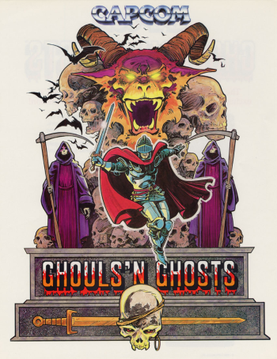
Ghouls 'n Ghosts, known as Dai Makaimura in Japan, is a side-scrolling platform game developed by Capcom, released as an arcade video game in 1988 and ported to home platforms. It is the sequel to Ghosts 'n Goblins and the second game in the Ghosts 'n Goblins series.
Sega Meganet, also known as the Net Work System, was an online service for the Mega Drive in Japan and later Brazil. Utilizing dial-up Internet access, Meganet was Sega's first online multiplayer gaming service, and functioned on a pay to play basis. The system functioned through the use of a peripheral called the Mega Modem and offered several unique titles that could be downloaded, and a few could be played competitively with friends. In addition, it shared technology and equipment with more serious services such as the Mega Anser, used for banking purposes. Though the system was announced for North America under the rebranded name "Tele-Genesis", it was never released for that region. Ultimately, the Meganet service would be short-lived, lasting approximately a year before it was discontinued, but would serve as a precursor to the Sega Channel and XBAND services, as well as a predecessor to online gaming services for video game consoles. Retrospective feedback praises the attempt by Sega to introduce online gaming, but criticizes the service for its logistical issues and lack of titles.

The Sega Genesis, also known as the Mega Drive outside North America, is a 16-bit fourth generation home video game console developed and sold by Sega. It was Sega's third console and the successor to the Master System. Sega released it in 1988 in Japan as the Mega Drive, and in 1989 in North America as the Genesis. In 1990, it was distributed as the Mega Drive by Virgin Mastertronic in Europe, Ozisoft in Australasia, and Tectoy in Brazil. In South Korea, it was distributed by Samsung Electronics as the Super Gam*Boy and later the Super Aladdin Boy.
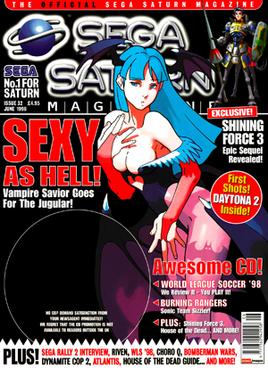
Sega Saturn Magazine was a monthly magazine from England covering the Sega Saturn, a home video game console. It held the official Saturn magazine license for the UK, and some issues included a demo CD created by Sega, Sega Flash, which included playable games and game footage. In 1997, the magazine reported a readership of 30,140. The last issue, 37, was published in November 1998.

Thunder Force IV, known in North America as Lightening Force: Quest for the Darkstar, is a shoot 'em up video game developed and published by Technosoft for the Mega Drive in 1992. It is the fourth installment in Technosoft's Thunder Force series, and the third and final one created for the Mega Drive. It was developed by the team at Technosoft that ported Devil's Crush to the Mega Drive rather than the team that developed the previous Thunder Force games. Like its predecessors, it is a horizontally scrolling shooter, but it also features extensive vertical scrolling with large playing fields.
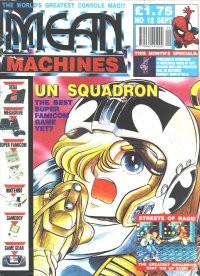
Mean Machines was a multi-format video game magazine published between 1990 and 1992 in the United Kingdom.
Europress was a British magazine and software publisher based in Adlington, near Macclesfield, Cheshire. Their magazine publishing business was previously known as Database Publications. The software division was renamed in 1999 to Actualize.
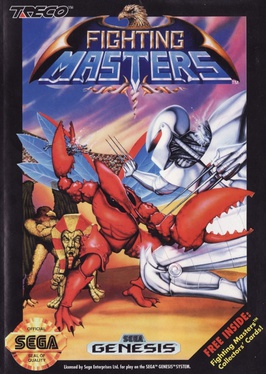
Fighting Masters is a 1991 fighting video game developed by Aicom and ALU, and published for the Sega Genesis in Japan and later in North America by Treco. In the game, players assume the role of a hero to fight against an assortment of opponents on an apocalyptic setting to face against an entity known as Lord Valgasu. Co-directed by Hajime Kusano and Ramō Kobayashi, the title was created by some of the same team that would later work on various projects at Almanic Corporation such as E.V.O.: Search for Eden. It was met with mixed reception from critics since its release.

Ayrton Senna's Super Monaco GP II is an arcade-style Formula One racing video game developed and manufactured by Sega for the Sega Genesis and Mega Drive, Master System, and the Game Gear in 1992. It is a follow-up to Super Monaco GP. The game was also endorsed by, and had technical input from, the then-Formula One champion Ayrton Senna. Gameplay includes a World Championship season featuring recreations of the tracks in the 1991 Formula One World Championship, along with a three-race "Senna GP" mode set on fictional tracks.
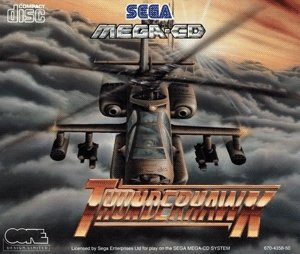
Thunderhawk, known as AH-3 Thunderstrike in North America, is a combat flight simulation video game developed and published by Core Design and released for Amiga and MS-DOS in 1992. A remake was made and published by JVC Musical Industries for Sega CD in 1993 and for MS-DOS in 1996. An Atari Jaguar CD port was planned but never released. In the game, the player flies a fictional AH-73M attack helicopter.

Tommy Lasorda Baseball is a 1989 baseball video game developed and published by Sega as one of the six launch titles for the Sega Genesis in the North America and for the Sega Mega-Tech arcade system. It is a follow-up to the arcade game Super League (1987). It prominently features former MLB player Tommy Lasorda, who was manager of the Los Angeles Dodgers at the time. In the game, players compete with either AI-controlled opponents or against other players across single exhibitions, open matches or a 30-game season.

Mega was a British monthly magazine that covered the Mega Drive video game console. During its time as one of the main Mega Drive publications, Mega covered the "golden age" of the Sega Mega Drive from 1992 to 1995. The magazine went through many changes including a re-design in content and layout before being sold to a rival publisher.
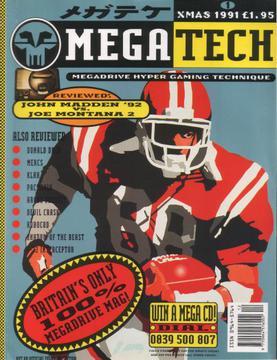
MegaTech was a publication from EMAP aimed specifically at the Sega Mega Drive gaming market. The magazine was started in 1991. The launch editorial consisted of a small team including Paul Glancey (editor) and Mark Patterson. It was published monthly. In 1993 the magazine was acquired by Maverick Magazines. It ceased publication in 1994 when it was merged into Mega magazine.

Sega Power, initially known as S: The Sega Magazine, was a Future publication aimed at the Sega range of consoles, including the Master System, Mega Drive, Game Gear and later on the Mega-CD, 32X and Saturn. The magazine was later relaunched as Saturn Power when the other Sega consoles were discontinued.

Sega Pro was the first publication from Paragon Publishing and catered for the Sega consoles: the Master System, Game Gear and the Mega Drive. Early editorial staff included Dominic Handy (editor), Les Ellis, Dave Perry (designer), James Scullion and Damian Butt as staff writers. The magazine existed between 1991 and 1996. A German edition of Sega Pro was also published (1992-1994).
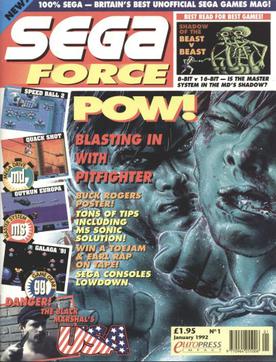
Sega Force was an early 1990s publication that covered the Sega console range.

Paragon Publishing Ltd was a magazine publisher in the UK, which published computer games and other entertainment titles from 1991 to 2003.

Fire Shark is a 1989 vertically scrolling shooter arcade video game developed and published by Toaplan in Japan and Europe, and by Romstar in North America. It is the sequel to Flying Shark, a game released in 1987 on multiple platforms. Set in the year 1991, the game focuses on a mysterious armada launching a worldwide attack from a small island in the Mediterranean Sea. Players take control of the titular biplane to counterattack the enemy forces.















